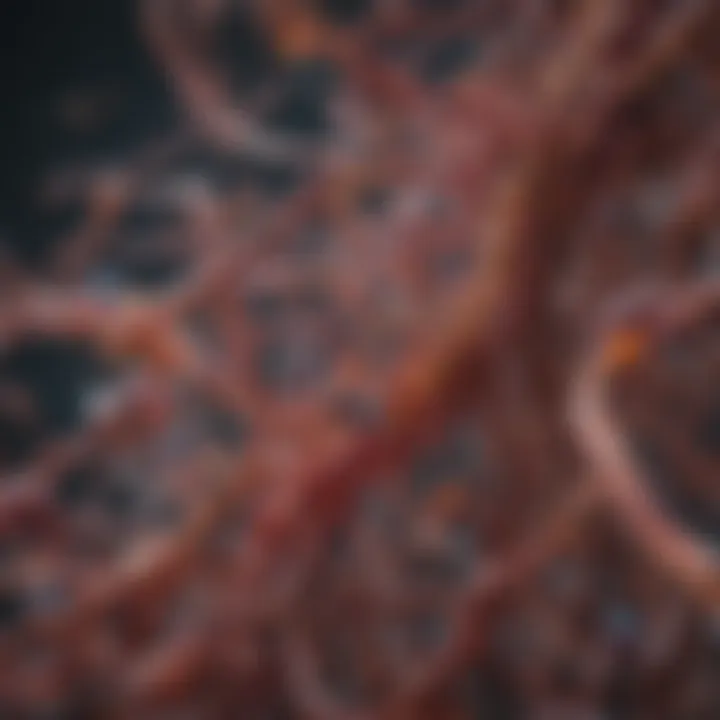Exploring the Microbial Landscape of the Human Body


Intro
The human body, often seen as a singular entity, is actually a vibrant, bustling microcosm teeming with life. From the moment we enter the world, we are colonized by an array of microorganisms that shape our health, our immune systems, and even our mood. The intricate ecosystem that is our microbiome functions not just as passive inhabitants but as active participants influencing a myriad of processes within us. This rich narrative explores these microbial communities, their roles, and the delicate balance that exists between them and the human host.
Research Context
Background and Rationale
In recent years, the conversation around human health has expanded from a sole focus on the human genome to a more encompassing perspective that includes the microbiome. Why is this shift important? Well, the sheer number of microbes residing within us is staggering— estimates suggest that microbial cells outnumber human cells by a factor of ten. This ratchotic imbalance raises questions about what these microorganisms mean for our day-to-day lives and overall well-being. Further, understanding how these microorganisms interact with our body can unlock new doors for treating various conditions and enhancing health.
Literature Review
A growing body of literature underscores the importance of the microbiome in numerous health conditions, from gastrointestinal issues to metabolic disorders. Notable studies have revealed that an imbalanced or dysbiotic microbiome is linked to diseases such as obesity, diabetes, and even depression. Research published in high-impact journals has noted that our microbial relationships are dynamic, changing with factors like diet, lifestyle, and environment.
Moreover, ongoing advancements in sequencing technologies have made it feasible to explore previously uncharted territories of the microbiome. Such breakthroughs allow scientists to identify not just which microbes are present, but how they interact with each other and with our bodies, setting the stage for potential therapeutic interventions and personalized medicine.
Methodology
Research Design
The exploration of the microbiome necessitates a multi-faceted approach. Observational studies and clinical trials often form the backbone of microbiome research, allowing scientists to gather data on microbial populations and their interactions with human physiology under various conditions. These designs are complemented by controlled laboratory studies that delve deeper into the microbial functions and their metabolic pathways.
Data Collection Methods
Data collection for microbiome analysis typically involves extensive sampling from various body sites, including the gut, skin, mouth, and more. Techniques such as 16S ribosomal RNA gene sequencing and metagenomic sequencing are crucial for profiling microbial communities. These methods allow researchers to assess not just the presence of bacteria, but also their relative abundance and diversity, providing a clearer image of the microbiological symphony at play within us.
Prologue to Human Microbiome
The microbial world residing in the human body is a topic that is gaining traction in both scientific research and public interest. This section serves as a foundational entry point, shedding light on the significance of understanding our microbiome. From health implications to evolutionary perspectives, the importance of this topic cannot be overstated.
Definition and Importance
The human microbiome refers to the collection of trillions of microorganisms—bacteria, viruses, fungi, and more—living symbiotically within and on us. This microbial community is not merely a passive inhabitant but plays a pivotal role in our overall well-being. The composition and balance of these microorganisms can influence digestion, immune responses, and even mood regulation.
Research has shown that disruptions in the microbiome can lead to a plethora of health issues, from gastrointestinal disorders to heightened susceptibility to infections. Understanding this delicate ecosystem is essential not only for addressing current health challenges but also for exploring avenues in preventative medicine. Without a proper grasp of the microbiome's functions, we risk neglecting a crucial aspect of human health.
As we delve into this intricate topic, consider how you might be affected by your own microbial residents. Are they aiding you in maintaining your health, or are they contributing to an underlying problem? This sets the stage for a deeper exploration of how we can harness the power of our microbiome—its benefits and the potential risks it may carry.
Historical Context of Microbial Research
The journey into the world of microbes began long before the term "microbiome" was coined. In the late 19th century, pioneers such as Louis Pasteur and Robert Koch laid the groundwork for microbiology. Their work focused predominantly on pathogenic bacteria that caused diseases, which pushed the exploration of microbial life into the shadows of relativity.
However, in the 20th century, the perspective started to shift. Researchers began uncovering the beneficial roles that certain microbes play. The discovery of probiotics in yogurt exemplified a turning point, showcasing how some bacteria provide health benefits, instead of just being viewed as agents of disease.
Fast forward to today, and microbial research has exploded. The advent of advanced sequencing techniques has allowed scientists to analyze the composition of the microbiome with greater precision. Now, an intricate tapestry of interactions is being unveiled, one that involves collaboration between countless microbial species and their human hosts. This ongoing research continues to enrich our understanding of how these tiny beings impact everything from our immune system to our mental health.
"The microbiome is not merely a collection of bacteria; it's an ecosystem that challenges our understanding of health and disease."
Through this introduction, we can see that recognizing the importance of the microbiome is pivotal for future research and applications. As we address the subsequent sections, a clearer picture of the complexities within our microbial landscape will emerge, offering insight into the profound connection we share with these microorganisms.
Microbial Population Estimates
Understanding the microbial population estimates within the human body is crucial for grasping the sheer scale and complexity of our microbiome. This segment addresses the myriad microorganisms that inhabit us, revealing why these estimates matter not just for academic curiosity but for practical health considerations. By examining the quantity and types of microbes, researchers can uncover relationships and impacts that these organisms have on our health and well-being. Here, we'll peek into the actual numbers and draw pivotal comparisons with the cells that comprise our own bodies.
Total Number of Microbes in the Human Body
Estimates suggest that the human body harbors trillions of microbes. Around 30 to 60 trillion bacteria alone reside within us, forming a community that can outnumber our own cells by a factor of 10. A single individual's microflora might visualize as a bustling city, with bacteria undertaking roles akin to workers, forming a vibrant ecosystem that plays a pivotal role in digestion, metabolism, and even immune defense.
One such remarkable study highlighted that the gut alone hosts the heaviest diversity of bacteria, with nearly a thousand distinct species living harmoniously. Meanwhile, the skin offers a different microbial playground; staphylococci and micrococci thrive there, adapting uniquely to the environment they find.
"Each person carries a distinct microbial fingerprint, shaped by diet, environment, and individual genetics."
This variability means that no two individuals share exactly the same composition of microbes, an aspect vital for personalizing medicine and understanding disease states.
Comparative Analysis with Human Cells
When comparing microbes to human cells, the numbers can be quite eye-opening. While human cells are generally estimated to total around 30 trillion, the microbes residing inside us can push that number to an astounding upwards of 100 trillion when accounting for all types. It brings forth an intriguing scenario: are we merely vessels for these microbes?


The sheer weight of this microbial mass, factoring in their metabolic capabilities, plays significant roles in our health. Microbes are not just passive bystanders; they are active participants.
This symbiotic relationship indicates that microbes influence numerous bodily functions, from vitamin synthesis to food digestion, and even mental health through the gut-brain axis. It's not just about quantity, but also the relationships we cultivate with these microorganisms, which can be the tall tale of our health narrative.
In summary, understanding microbial population estimates illuminates the vast hidden world residing within us. This insight not only enriches our knowledge about human biology but lays the groundwork for future studies aimed at delving deeper into the influence this microbial society has on our lives.
Types of Microbes Found in the Human Body
Understanding the types of microbes that dwell within our bodies is more than just an academic endeavor; it's integral to our grasp of human health. The microbial communities are diverse, each type performing distinctive functions that contribute to health, wellness, and sometimes disease. In this section, we'll break down the primary categories of microbes: bacteria, viruses, fungi, and archaea. By doing so, we can appreciate their roles and their potential influences on the human host.
Bacteria
Bacteria are perhaps the most well-known type of microbe present in humans. Ranging from beneficial to harmful, they play significant roles in a myriad of bodily functions. The gut alone is home to a vast number of bacterial species, each contributing to digestion and absorption of nutrients. For example, Lactobacillus and Bifidobacterium are beneficial bacteria that aid in fermenting dietary fibers, producing short-chain fatty acids—essential for the health of our gut lining.
However, not all bacteria are beneficial. Pathogens, like Escherichia coli and Staphylococcus aureus, can cause infections if they proliferate uncontrollably or find themselves in an unsuitable environment. The balance between beneficial and harmful bacteria is crucial, and this equilibrium can be easily disrupted by factors such as diet, antibiotics, or even stress.
Viruses
While viruses often get a bad rap, not all of them are detrimental. In fact, a significant number of viruses in the human body are adenoviruses, which typically only cause mild illnesses. Some viruses can integrate themselves into human DNA, potentially influencing health outcomes. These viruses can also interact with bacteria in a relationship known as lysogeny, where they can lead to the death of harmful bacterial strains while sparing beneficial ones.
Research in this area is ongoing, including studies into the role of bacteriophages—viruses that specifically target bacteria—to combat bacterial infections. They could serve as alternative treatments for antibiotic-resistant strains, marking them as potential heroes in the fight against infectious diseases.
Fungi
Fungi, although they are less discussed in the context of human microbiota, are a vital part of the microbial community. The human body hosts numerous fungal species, predominantly Candida, found in various body sites, including the gut and mucosal surfaces. While generally harmless, an imbalance can lead to overgrowth, resulting in candidiasis, which can cause discomfort or more severe health issues in immunocompromised individuals.
Interestingly, fungi contribute to the overall microbial diversity. For instance, they can help modulate the immune response and interact with gut bacteria in ways that enhance nutrient absorption, offering a symbiotic relationship that illustrates the intricate web of our microbiome.
Archaea
Last but not least are archaea, a type of microbe that operates in extreme environments but also has a home within the human body. Historically seen as a distinct group, archaea resemble bacteria at a glance yet possess unique biochemical properties. One of the most well-known archaea in humans is Methanobrevibacter smithii, which thrives in the intestines and plays a role in digestive processes by breaking down hydrogen gas into methane.
While the role of archaea in human health is still being explored, their presence indicates a complex microbial landscape that we are just beginning to understand. Investigating these four types of microbes not only draws a detailed picture of the microbial communities in our bodies but also highlights the significances of maintaining a balanced microbiome—essential for overall health.
"Microbes are like the inhabitants of a huge city, each with their own jobs and roles in the ecosystem, working together to create a stable environment for the host."
Microbial Diversity Across Body Sites
The microbial landscape within the human body is not uniformly distributed; rather, it is shaped by various factors and exists in distinct communities across different sites. This diversity is crucial, as it plays a significant role in maintaining health, protecting against pathogens, and influencing bodily functions. By understanding the specific microbial populations inhabiting diverse body sites, researchers can gain insights into how these microorganisms interact with each other and with the human host.
Skin Microbiota
The skin is often the first line of defense against external pathogens, and its microbiota plays a pivotal role in this. It is host to a myriad of bacteria, fungi, and viruses that engage in complex interactions. For instance, Staphylococcus epidermidis is a common resident of human skin that helps to prevent pathogen colonization by competing for resources. Adding to this, the skin microbiota contributes to the production of substances that can inhibit pathogens.
Environmental factors, such as climate and hygiene practices, can significantly impact the diversity and composition of skin microbes. For example, individuals living in humid climates may host a different array of microorganisms compared to those in arid regions. The balance among these microbes is delicate; disruptions can lead to skin conditions like eczema or acne. This shows how vital our tiny companions really are, functioning not just as bystanders, but as active participants in our health.
Oral Microbiota
The mouth is a complex ecosystem, hosting bacteria, archaea, viruses, and fungi. Notable examples include Streptococcus mutans, which contributes to tooth decay, and Lactobacillus species that play a role in health. Oral microbiota not only relates to dental health but also can influence overall systemic health. An imbalance, or dysbiosis, in these microbial communities can lead to periodontal disease and has even been linked to conditions such as cardiovascular disease.
The oral environment is constantly changing, affected by diet, hygiene, and even stress. For instance, higher sugar intake can lead to a proliferation of harmful bacteria, while a fiber-rich diet can support beneficial ones. Research continues to delve into how maintaining a healthy balance within oral microbiota can be a cornerstone for various health outcomes.
Gut Microbiota
Perhaps the most studied of all microbial communities, the gut microbiota is a powerhouse behind digestive health. Comprising trillions of microorganisms, it assists in breaking down food, synthesizing vitamins, and supporting the immune system. The diversity of gut microbes, including Bacteroides, Firmicutes, and Actinobacteria, plays a critical role in metabolic processes.
Diet heavily influences gut microbial diversity. A varied diet rich in fiber promotes a more diverse microbiome, which is essential for gut health. Moreover, the gut microbiota can also affect mood and behavior through the gut-brain axis, suggesting that the balance of microbes can significantly impact mental as well as physical health. Thus, maintaining a healthy gut is fundamental – not only for digestion but for overall well-being.
Respiratory Tract Microbiota
While often overshadowed by the more pronounced microbiomes of the gut and skin, the respiratory tract also harbors its own unique microbial population. Bacteria such as Streptococcus pneumoniae can exist in healthy individuals without causing harm, suggesting that they play a role in a balanced respiratory microbiome. Changes in this balance, however, can lead to respiratory illnesses, such as chronic obstructive pulmonary disease or asthma.
Additionally, recent research highlights how the oral microbiome might influence the respiratory microbiome. Inhaling pollutants or pathogens can disturb the delicate community of microbes in the lungs, leading to inflammation and disease. The interconnectedness of microbial health across body sites demonstrates that we must view our microorganisms not as isolated entities but as parts of a larger, interconnected ecosystem, where each component has its role and impact.
Interactions Between Microbes and the Host
The interactions between microbes and the human host are foundational to understanding the overall health and function of our bodies. These relationships can be quite intricate, reflecting a balance of benefits and potential risks. The human microbiome, comprising trillions of microorganisms, evolves in concert with us, influencing processes from digestion to immune response.
Every day, the interactions that happen between these microbes and our own cells shape our wellbeing in a myriad of ways. The diversity and composition of these microbial communities can determine how our bodies respond to diseases, how well we absorb nutrients, and even how our immune system navigates its myriad challenges. Given the integral role they play, understanding both symbiotic and pathogenic interactions can pave the way for better healthcare strategies and interventions.


Symbiotic Relationships
Symbiotic relationships between humans and their associated microbes are crucial. These can range from mutualism, where both parties benefit, to commensalism, where one party benefits without impacting the other negatively. For instance, consider the gut microbiome. Bacteria like Lactobacillus and Bifidobacterium assist in the breakdown of complex carbohydrates and synthesis of certain vitamins, creating a win-win situation.
- Nutrient Absorption: They can produce short-chain fatty acids that our body utilizes for energy.
- Immune Support: These microbes play an important role in training our immune system to distinguish between harmful pathogens and benign substances.
- Protection: By occupying ecological niches, they can prevent pathogenic organisms from establishing a foothold.
"Microbes are like tiny bodyguards, watchdogs that keep harmful invaders at bay while providing essential services to their hosts."
The benefits derived from these symbiotic relationships underscore the importance of maintaining a diverse and balanced microbiome, especially through dietary choices and lifestyle.
Pathogenic Potential
On the flip side, not all microbial interactions are beneficial. Pathogenic microbes can disrupt the balance, leading to disease and dysfunction. These can be opportunistic, taking advantage of a weakened immune system or other vulnerabilities in the host. For example, the bacterium Clostridium difficile can cause severe gastrointestinal distress, especially after antibiotic therapy disrupts the normal gut flora.
- Immune Evasion: Some pathogens have evolved mechanisms to evade detection or eliminate immune responses, complicating treatment.
- Inflammation: Pathogenic interactions can trigger excessive immune responses, resulting in inflammation that can be damaging to tissues.
- Transmission: Understanding how pathogens operate can help develop strategies to combat infections and protect the microbiome.
In summary, the interactions between microbes and the human host reflect a delicate balance. The coexistence of beneficial and harmful microorganisms poses ongoing challenges and opportunities in health research and medical practice.
Factors Influencing Microbial Composition
The composition of microbes within the human body is not set in stone; rather, it fluctuates based on a myriad of factors. Understanding these influences is essential for grasping how our microbial communities function and interact with us. Different elements such as diet, lifestyle, environmental exposure, and even genetic factors play a pivotal role in shaping the diverse microbial ecosystems that inhabit our bodies. Such knowledge not only enlightens our understanding of health but also allows us to explore innovative avenues for treatment and preventive care.
Dietary Impact
Diet stands out as one of the most significant influences on the microbial composition within us. The foods we consume fuel not only our bodies but our gut residents as well. Research shows that diets high in fiber encourage the growth of beneficial bacteria while diets rich in sugars and fats can promote the proliferation of harmful microbes. For example, a Mediterranean diet, abundant in fruits, vegetables, nuts, and healthy fats, has been linked to a more diverse and stable microbiome.
- Fiber-rich foods like beans, lentils, and oats foster the growth of bacteria such as Bifidobacteria and Lactobacilli.
- The regular intake of fermented foods like yogurt, kimchi, and sauerkraut can introduce prebiotics and probiotics that positively affect our gut flora.
Thus, what we eat shapes not just our waistlines but also the tiny organisms in our guts, impacting digestion, immunity, and even mood. The interplay between nutrition and our microbiome illustrates the adage:
You are what you eat.
Lifestyle and Environmental Factors
Lifestyle choices too wield considerable influence over our microbial inhabitants. Factors such as physical activity, stress levels, and hygiene practices can dramatically affect microbial diversity. Regular exercise, for example, enhances gut microbiota diversity, which in turn is linked to better immune function.
- Urban living exposes individuals to a different microbial pool than rural living, often resulting in reduced exposure to nature's diverse ecosystems.
- The use of antibiotics, while sometimes necessary, can decimate beneficial bacteria, leading to imbalances that pave the way for pathogenic growth.
Furthermore, conditions such as sleep quality and stress levels can lead to alterations in the microbiome. High stress might contribute to an imbalance known as dysbiosis, where harmful bacteria thrive at the expense of beneficial ones. This chain of events often spirals into digestive issues and other health concerns.
Genetic Predispositions
Beyond external factors, genetics also comes into play in shaping our microbiomes. Research indicates that genetic variation may influence how microbe populations establish and thrive within an individual. This genetic predisposition can explain why two people with similar diets might have quite different microbial profiles.
- Certain genes may affect the immune system's ability to respond to different bacteria, creating a unique environment where specific microbes can flourish.
- Studies suggest sibling microbial similarity, hinting at hereditary influences on microbial composition.
In sum, the tapestry of factors influencing microbial composition is intricate and multifaceted. Understanding these components reveals not just how our microbes relate to our health but also highlights the importance of personalized approaches to diet, lifestyle, and treatment. The more we understand our unique microbial landscapes, the better equipped we become to foster optimal health and well-being.
Microbial Influence on Human Health
The intricate relationship between microbes and human health is a topic of considerable importance. The microbiome plays multifaceted roles, impacting everything from our immune defense mechanisms to our vulnerability to chronic diseases. Delving into how these microorganisms shape our well-being provides insights that are crucial for both treatment and prevention strategies.
Role in Immune Function
Microbes are key players in the development and functioning of our immune system. They help train immune cells, teaching them to differentiate between harmful invaders and benign substances. For instance, certain bacteria in the gut can stimulate the production of antibodies and modulate inflammatory responses.
Research indicates that a diverse microbiome correlates with stronger immune responses. When we maintain a rich variety of microbes, our immune system is better equipped to fend off infections and other health issues. A healthy gut microbiome can even influence conditions beyond the gut, affecting systemic immunity.
"The gut isn't just a digestive organ; it's a crucial ally in our immune defenses."
Connection to Chronic Diseases
The connection between microbes and chronic diseases has garnered increasing attention. Dysbiosis, or an imbalance in microbial populations, has been implicated in several conditions, including obesity, diabetes, and cardiovascular diseases. In such cases, harmful bacteria may prevail over protective ones, leading to inflammation and tissue damage.
Some studies suggest that specific microbial profiles can predict the likelihood of developing diabetes or other metabolic disorders. Factors such as diet and lifestyle can dramatically alter these profiles, suggesting that managing our microbial environment may provide a pathway to healthier living.
- Chronic diseases linked to microbial imbalance include:
- Obesity
- Type 2 Diabetes
- Inflammatory Bowel Disease (IBD)


Potential in Probiotics and Treatments
Probiotics have carved out a niche in health and wellness discussions, often touted for their potential to restore balance to the microbiome. These live microorganisms, when administered in adequate amounts, can confer health benefits by replenishing beneficial bacteria.
Research shows that certain strains of probiotics can alleviate gastrointestinal issues, enhance immune response, and even assist in mental health treatment. For example, Lactobacillus and Bifidobacterium species are frequently used to promote gut health. Moreover, ongoing studies are exploring the use of targeted probiotics to manage chronic diseases, further illuminating their potential role in preventive healthcare.
To tap into this microbial bounty, one can incorporate:
- Probiotic-rich foods like yogurt and kefir
- Fermented vegetables such as kimchi and sauerkraut
In summary, the influence of microorganisms on human health extends beyond mere colonization. Their roles in immune function, connections to chronic diseases, and therapeutic potentials through probiotics paint a complex yet fascinating picture of how we can harness microbial life for better health.
Current Research Trends in Microbiome Studies
The fast-evolving field of microbiome research is unveiling layers of complexity that reside within the human body. Not only is this exploration reshaping our understanding of health and disease, but it's also pushing the boundaries of how we approach medical research. The current trends demonstrate a concerted effort to bridge technology with biology, all while integrating various disciplines to paint a broader picture.
Technological Innovations
Emerging technologies are at the forefront of microbiome research. Techniques such as next-generation sequencing have revolutionized our ability to not just identify but catalog diverse microbial species inhabiting the human body. This method offers speed and cost-effectiveness, breaking down previous barriers that limited large-scale studies. Researchers are now capable of processing samples from thousands of patients in a fraction of the time with heightened precision.
Moreover, advancements in bioinformatics enable us to handle the colossal datasets generated from these studies more efficiently. These tools not only help in processing data but also in interpreting complex interactions and patterns among microbial populations. Utilizing artificial intelligence for data recognition is a game changer, offering insights that were previously difficult to obtain. This leads to more targeted research in microbiome functionality and its implications in various body systems.
In addition, techniques like metagenomics allow researchers to study genetic material recovered directly from environmental samples, providing a window into gene function and metabolic pathways that affect human health. The integration of single-cell analysis further enhances understanding at a granular level, paving the way for newer therapeutic strategies.
Interdisciplinary Approaches
Today’s microbiome research isn't confined within a single discipline. Instead, it’s a melting pot of genetics, immunology, computational biology, and nutrition, making it holistically richer. This interdisciplinary approach facilitates a more nuanced understanding of how microbiomes influence both health and disease.
For instance, collaborations between biologists and nutritionists reveal how dietary choices impact microbial composition. Such insights are crucial for developing personalized nutrition strategies aimed at enhancing health or preventing chronic diseases.
Another interesting angle is the fusion of psychology with microbiome studies. New theories suggest that gut health can influence moods and mental well-being. Studies demonstrating the gut-brain axis are gaining traction, making it essential to consider an array of research perspectives.
"The integration of various fields can lead to groundbreaking strategies and create a better-informed approach to health science."
In summary, current trends in microbiome research encapsulate a lively amalgamation of technology and interdisciplinary collaboration. As we venture further down this path, the insights gathered can transform healthcare paradigms, shifting from a one-size-fits-all approach to tailored interventions that take into account the unique microbial landscape of individuals. This in-depth exploration promises a future where microbial health is recognized as central to overall wellness.
Challenges in Microbiome Research
Understanding the microbial landscape of the human body is no easy task. The complexity of microbial ecosystems within us goes beyond mere numbers or types of organisms. It’s essential to shine a light on the challenges researchers face in exploring this intricate community. Identifying these challenges not only helps to advance microbiome studies but also underlines the importance of a multi-faceted approach to achieve meaningful results.
Complexity of Microbial Ecosystems
The human microbiome is a living tapestry, composed of trillions of microbes that interact with our bodies in myriad ways. One major challenge is deciphering the intricate interactions within these ecosystems. Each individual hosts a unique ensemble of microbes, influenced by factors such as genetics, diet, and environment, leading to variability that's hard to standardize in research.
The heterogeneity of microbial populations across different body sites adds another layer of complexity. For example, the gut microbiome is vastly different from that found on the skin. This spatial diversity raises questions about how microbial dynamics change in response to physiological or environmental shifts. It becomes crucial to adopt advanced metagenomic approaches to probe these ecosystems effectively.
Furthermore, the reliance on traditional culturing methods is limiting because many microbes are unculturable under standard laboratory conditions. This underrepresentation often leads to an incomplete understanding of the overall microbial populace. Researchers are now leaning towards cutting-edge technologies, such as shotgun sequencing, to shed light on the hidden parts of our microbiome. Nevertheless, while these methods offer great promise, they also introduce a slew of data management and interpretation issues, as extracting clear insights from vast genetic data can be daunting.
Ethical Considerations
As with any burgeoning field, ethical challenges loom over microbiome research. Firstly, there is a pressing need to consider informed consent when working with human subjects. The personal nature of microbiome data—reflecting unique genetic and health-related information—demands rigorous ethical oversight to safeguard participant privacy. Researchers must navigate the delicate balance between seeking valuable data and respecting the autonomy of individuals.
Moreover, the potential for misusing microbiome data raises ethical concerns. There’s a risk that this information could be exploited in ways that lead to discrimination or stigmatization, particularly in health insurance or employment contexts. It is vital to establish robust ethical frameworks and guidelines to guide research practices, ensuring that the pursuit of knowledge does not come at the cost of personal rights.
The interplay between science and ethics in microbiome studies extends to how outcomes are translated into public knowledge. Misleading representations can lead to public misunderstanding regarding the importance or dangers of microbiome interventions, such as probiotics. Therefore, clear and accurate communication of research findings becomes paramount.
As we delve deeper into the vast universe of the human microbiome, overcoming these challenges is not just about expanding our scientific understanding. It’s about laying down a strong foundation for responsible research that respects and protects human dignity while paving the way for future biomedical advancements.
Closure: The Future of Microbiome Exploration
Understanding the microbiome is becoming a pivotal part of modern science. The implications are vast and span multiple fields, including medicine, nutrition, and ecology. Microbes, often seen merely as pathogens, are now realized to be intricate players in our health, influencing everything from digestion to immune responses. The future of microbiome research holds promise not just for treating diseases but for preventing them entirely. Through deeper exploration into this world within us, we might unearth solutions to chronic conditions that plague society today.
Implications for Medicine and Health
As researchers unravel the complexities of the human microbiome, the implications for medicine are profound.
- Personalized Medicine: Tailoring treatments based on an individual’s microbial composition could revolutionize how we approach diseases. Instead of a one-size-fits-all, therapies may be adapted to an individual's unique microbial community, improving efficacy and reducing side effects.
- Probiotics and Dietary Recommendations: Understanding how specific microbes affect health allows for better recommendations regarding probiotics. Instead of generic suggestions, advice could be more targeted, focusing on the strains that specifically benefit gut health or overall wellness.
- Novel Therapeutics: There's burgeoning interest in harnessing the microbiome as a source of new drugs. Bacterial metabolites might have therapeutic applications, potentially leading to new avenues for treatment of diseases like diabetes and obesity.
- Prevention of Disease: A key aspect of this exploration lies in prevention. By recognizing how certain microbial profiles contribute to diseases, steps may be taken to promote beneficial microbes through diet and lifestyle changes, potentially staving off health issues before they develop.
Ongoing Research Directions
The trajectory of microbiome research is ever-expanding, with several interesting paths emerging:
- Longitudinal Studies: Tracking changes in microbial communities over time may yield insights into how lifestyle changes, medications, and environmental factors influence our health.
- Microbiome-Gut-Brain Axis: Connections between gut bacteria and brain function are drawing attention. Future studies may create breakthroughs in understanding mental health issues and neurological disorders.
- Environmental Microbiomics: Research is looking beyond human health to understand how human activity affects the microbiomes of our surroundings, including soils and waterways, and how these communities, in turn, influence human health.
- Technology Integration: The convergence of artificial intelligence and microbiome research could enhance our understanding of microbial interactions and facilitate the design of new therapeutics.
As we stand on the brink of this revolution, the hope is that the insights gleaned from the microbial landscape will not only enhance individual health but may ultimately lead to improved public health strategies, shaping a healthier future for all.



